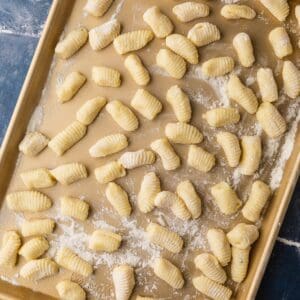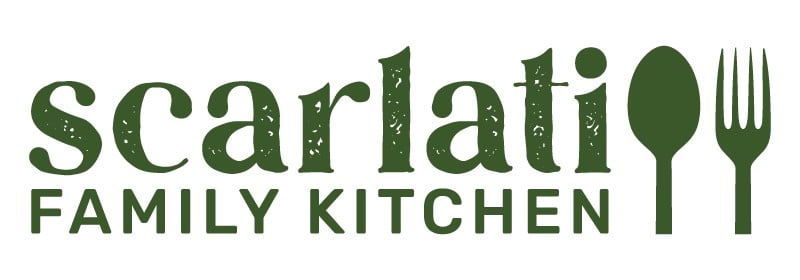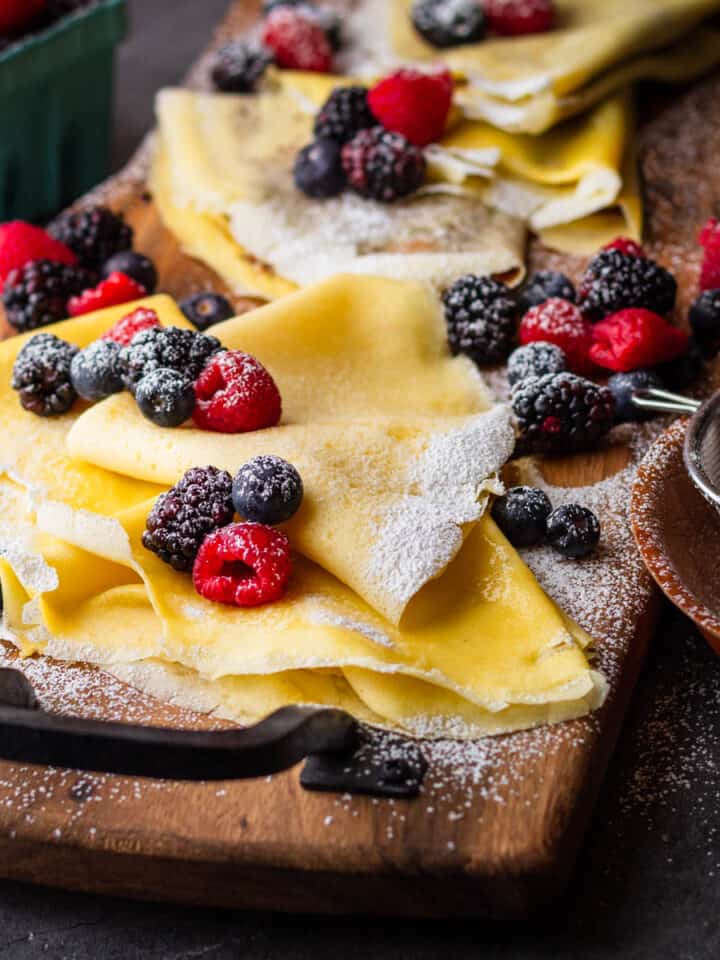
This easy Italian gnocchi recipe is one of the best homemade potato gnocchi recipes. Made with 4 ingredients, these soft and pillowy dumplings are perfect with your favorite sauce!

💭 What is Gnocchi?
Gnocchi is a potato dumpling that originated from northern Italy. The colder climate lends itself better to growing potatoes. It's also where most of the "heartier" Italian dishes like polenta or risotto come from.
It's said that the word gnocchi comes from the word "nocchio" meaning a knot in wood or "nocca", meaning knuckle.
There are many variations of gnocchi found in Italy. Other parts of the world also have their versions of it as well, such as German spaetzle.
Making gnocchi from scratch is a fun activity to do with the family. It takes a little bit of effort, but the taste and texture are nowhere close to the gnocchi you would buy from a store.
This homemade Italian gnocchi recipe is not unique. It consists of standard ratios required for an Italian potato gnocchi. What stands out is the key techniques needed to make sure you get the best gnocchi, every time.
Once you have mastered the technique, you can make all sorts of dishes, like my easy sausage and gnocchi recipe!
Jump to:
🥔 Ingredient notes

- Potatoes - My favorite type of potato to make gnocchi with is Yukon gold potatoes. They are an all-purpose potato that has a mid-range water content that is not too dry. Russet potatoes are another great potato to get fluffy gnocchi. They are starchy potatoes with low water content. Red potatoes or new potatoes are more waxy potatoes. These potatoes aren't recommended for making homemade gnocchi because of their low starch content. Substitute Yukon gold potatoes with sweet potatoes to make sweet potato gnocchi!
- Flour - All purpose flour is a great, multipurpose flour to use for gnocchi. 00 flour (affiliate link) is a fine ground Italian flour that can be used as well. It's a higher end specialty flour that is more expensive and not as readily available. It does produce a less sticky gluten, so it ensures a fluffy texture to your gnocchi.
🔪 Step by step instructions
First, rub the potatoes in olive oil and poke them several times with a sharp knife or fork on all sides. Lay them on a sheet pan and bake in the oven for 45 minutes to an hour. They are done when the largest potato is soft when you squeeze it with a towel or hot pad.
Transfer the potatoes to a large bowl and cover them with a towel. Let them steam in the bowl for 10-15 minutes.

Using a sharp knife or your hands, peel off the skins and discard. Process the peeled potatoes through a potato ricer, then weigh the mixture.
Add as much flour as needed based on the weight of the potatoes. For every pound of riced potatoes, you will need 1 cup of flour. Add the egg and a pinch of salt to the bowl along with the potatoes and flour.

Mix everything using hands or a wooden spoon, until the ingredients are combined. You can knead the dough a bit to make it cohesive but don't work it too much or the gnocchi will become gluey.
Turn the potato gnocchi dough out onto a floured surface. Use a bench scraper or a sharp knife to cut the dough into four pieces. Working one piece at a time, roll the dough into a long rope that is about one inch in diameter.

Then cut the rope of dough into approximately one inch pieces and use a gnocchi board or fork to shape the gnocchi.
Working one piece of dough at a time, roll the dough down the tines of a fork or the board, while pressing gently with your thumb. The gnocchi will start to roll down the board and then curl up over your thumb. Use your fingers to gently roll it over into an oval shape.

Repeat with the remaining gnocchi and lay them in a single layer on a floured surface or sheet pan so they don't stick together.
When you are done shaping, bring a large pot of water to boil over medium high heat. Add 1 Tablespoon of salt and then reduce the heat to medium. Add the fresh gnocchi to the boiling water and then stir gently to combine. Let the water come back to a boil and then cook for 1-2 minutes until they float to the surface.
Remove the gnocchi using a slotted spoon and add them directly to the sauce you will be serving them with.

If you ever don't recognize a tool or skill that is mentioned, be sure to look it up in our Glossary of Cooking Terms and Definitions for more information.
⭐ Expert tips
- Bake the potatoes instead of boiling them. Boiling them adds excess water which will throw off the ratios and then make the dough gummy.
- The best tip I have received was from Food and Wine to weigh the potatoes after you bake, peel, and rice them. This will give you a more accurate ratio when adding your flour for the best texture to the dough.
- The correct ratio for gnocchi is 1 cup of flour + 1 egg + pinch of salt for every 1 pound of cooked, peeled, and riced potato. In my experience, about 1 ¼ - 1 ½ pounds of raw potato will translate to about 1 pound of baked, peeled, and riced potato flesh.
- Bring the egg, potatoes, and flour to room temperature. This will make sure the dough comes together well for a super light gnocchi dough.
- Don't overwork the dough! Kneading or stirring the dough too much will over develop the gluten in it and make for a gummy or chewy gnocchi.
- If the dough is sticking to your hands or the gnocchi board, add just enough flour to prevent sticking. Adding too much flour will make make tough gnocchi.
- Make sure to lay the gnocchi in a single layer after shaping, otherwise they will clump together.
🥘 Alternative cooking methods
Instead of boiling the gnocchi in water, you can cook it directly in your sauce. Add extra sauce to the mixture as some of it will be absorbed during cooking.
⏲️ Make ahead instructions
Fresh gnocchi can sit out after shaping for only about 2 hours and then it needs to be cooked or frozen. For gnocchi that sits out a bit, cooking times may be slightly longer.
To freeze uncooked gnocchi, lay them in an even layer on a sheet pan lined with parchment and place them in the freezer. Once completely frozen, transfer to a zip top freezer bag or airtight container for up to 2 months. Cook the gnocchi directly from frozen. Cooking times will be longer.
🥡 Storage suggestions
Leftovers of this homemade gnocchi recipe will keep for up to 3 days in an airtight container in the refrigerator. Reheat leftovers in sauce over low heat on the stovetop or in the microwave until warmed through.
🍝 More Italian recipes
If you loved this easy Italian gnocchi recipe, check out these other Italian recipes that I know you will love too!
📖 Recipe

Easy Italian Gnocchi Recipe
Ingredients
- olive oil
- 1 ½ pounds yukon gold potatoes
- 1 cup all purpose flour, or 00 flour (affiliate link)
- 1 large egg, room temperature
- 1 pinch sea salt, plus extra for cooking the gnocchi
Instructions
- Preheat the oven to 400˚ and line a sheet pan with parchment paper.
- Rub the potatoes lightly with olive oil and poke them all over the surface with a fork or sharp knife.
- Bake them on the prepared sheet pan for 45-60 minutes, until the largest potatoes is soft when you squeeze it with a towel or hot pad.
- Place the hot potatoes in a bowl covered lightly with a kitchen towel to steam for 10-15 minutes. Then gently remove the skins with hands or a knife.
- Process the peeled potatoes through a potato ricer and then weigh the riced potatoes to determine how much flour will be needed. For every pound of baked, peeled and riced potato, 1 cup of flour is needed.
- Add enough flour to the bowl based on the weight of the potatoes and then add in the egg and a pinch of sea salt.
- Using hands or a wooden spoon, mix the ingredients together to form a soft dough. The dough can be kneaded slighty, but don't overwork it too much or it will make it gluey.
- Divide the dough into four pieces using a bench scraper or knife. Working one piece at a time, roll the dough into a long rope that is approximately one inch in diameter. Then, cut the rope into smaller pieces that are approximately one inch thick.
- Flour a gnocchi board or fork generously. Working one piece of dough at a time, roll the dough down the tines of a fork or down the board, while pressing gently with your thumb. The gnocchi will start to roll down the board and then curl up over your thumb. Use your fingers to gently roll it over into an oval shape.
- Place the finished shaped gnocchi pieces on a floured sheet pan or surface in a single layer so they don't stick together.
- Bring a large pot of water to boil over medium high heat and add 1 Tablespoon of salt.
- Reduce the heat to medium and add the gnocchi. Stir to make sure nothing sticks together and then bring the water back to a boil. Cook for 1-2 minutes until the gnocchi floats to the top.
- Remove the gnocchi with a slotted spoon or skimmer and place directly in the sauce it will be served in.
Notes
-
- Bake the potatoes instead of boiling for the best texture to the dough.
-
- Weigh the potatoes after you bake, peel and rice them for a more accurate ratio.
- 1 cup of flour + 1 egg + pinch of salt for every 1 pound of cooked, peeled and riced potato.
- Approximately 1 ¼ - 1 ½ pounds of raw potato will translate to about 1 pound of baked, peeled and riced potato flesh.
-
- Bring the egg, potatoes and flour to room temperature so the dough comes together easily.
-
- If the dough is sticking to the board or your hands, add just enough flour to prevent sticking. Adding too much flour will make tough gnocchi.
-
- Make sure to lay the gnocchi in a single layer after shaping, otherwise they will clump together.
- The gnocchi can be cooked directly in the sauce it's being served in, instead of boiling. A bit more sauce may need to be added as some will be absorbed during cooking.
Substitutions and Variations
-
- Potatoes - Russet potatoes are a starchy potato with low water content that will make good gnocchi. Red potatoes or new potatoes are a more waxy potato and are not recommended. Use sweet potatoes to make sweet potato gnocchi.
-
- Flour - All purpose flour (affiliate link) is a great, multipurpose flour to use for gnocchi. 00 flour (affiliate link) is a fine ground Italian flour that can be used as well. It does produce a less sticky gluten, but can be more expensive and harder to find.








Comments
No Comments